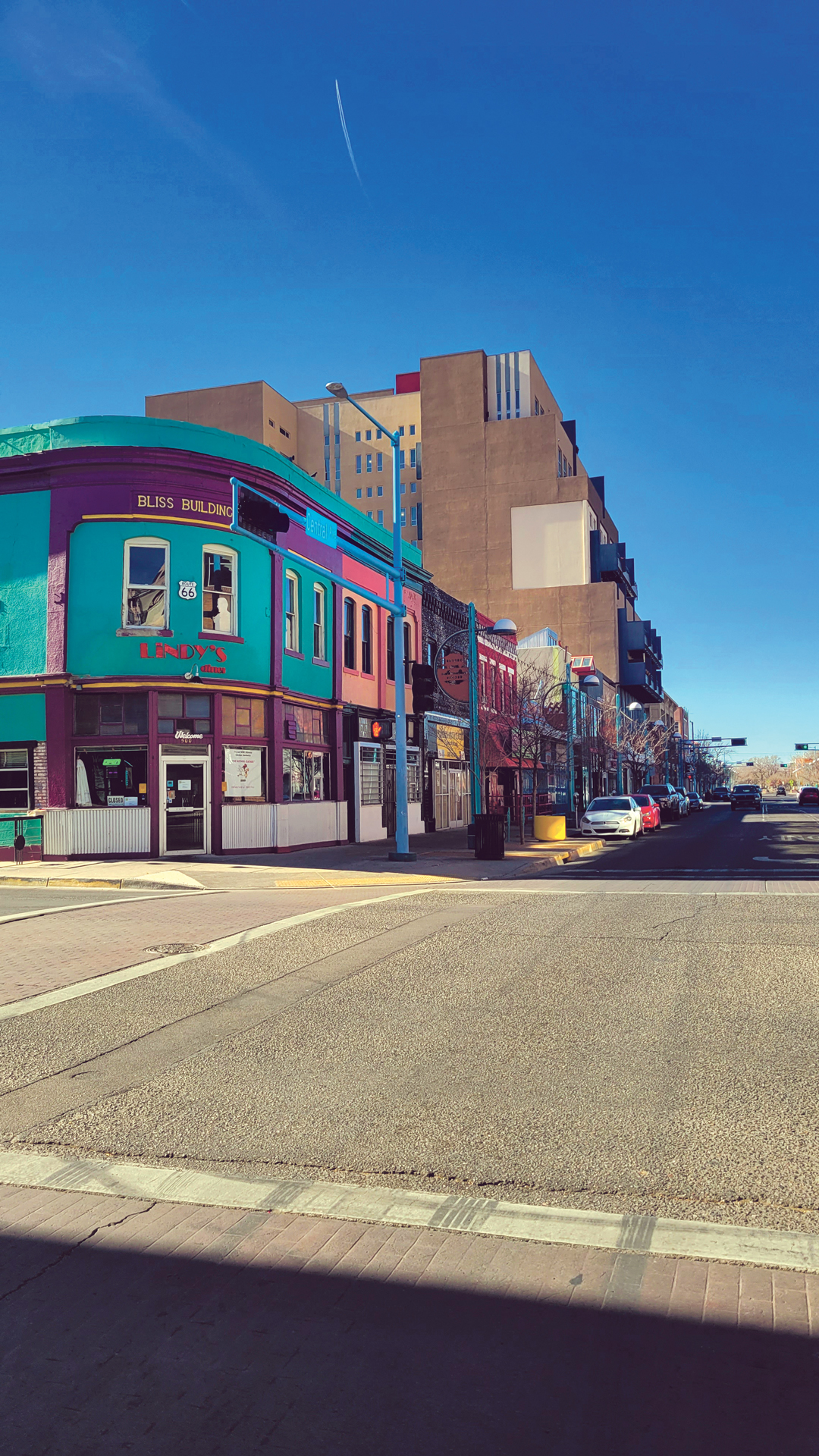
The Nostalgic Perfection of Route 66 Diner Pie
words and photos by Candolin Cook
On the early-1990s cult TV show Twin Peaks, lead character FBI agent Dale Cooper gave a piece of advice that I, and we all, should strive to live by: “Every day, once a day, give yourself a present.” Often, Agent Cooper’s present to himself was a thick slice of cherry pie and a “damn fine” cup of coffee from the local Double R Diner. A piece of pie—preferably warm and à la mode—is both a solid selection as a treat and as a diner order. While the overall fare at classic American diners can range from subpar to sublime, even the greasiest of greasy spoons tends to take special care and pride in their homemade pies. To give myself a present, I decided to sample the pie at two Albuquerque establishments located on a road synonymous with diner culture, Route 66 (a.k.a. Central Avenue). At each, I not only found some damn fine pie but also discovered a slice of local and American history.
While Central Avenue is considered Albuquerque’s Main Street, Route 66—spanning from Chicago to Los Angeles—was known as the Main Street of America in its prime. Coinciding with the proliferation of the automobile, the road quickly became a symbol of American mobility and freedom after it was established in 1926. Many Americans could now more easily travel cross-country for work, leisure, and opportunity—something desperately sought during the Depression era. One problem for early motorists, however, was a dearth in dining options along the still sparsely populated highway. To address the need for fast, dependable, and affordable meals along the way, savvy restaurateurs began opening diners along the roadside. Today, one of the oldest continuously operating restaurants on Route 66 sits on the corner of Fifth Street and Central Avenue in downtown Albuquerque.
Lindy’s Diner debuted as the Coney Island Sandwich Shop on New Year’s Day, 1929. An Albuquerque Journal advertisement announcing its opening proclaimed that it was the “most up-to-date” sandwich shop in New Mexico. A place where “Everyone Eats” and “Everybody [Is] Welcome.” Back then, New Mexicans could get a taste of New York by buying a Coney Island (chilli dog) for just five cents. Today, Lindy’s prices are still a bargain and its staff is just as welcoming.
I take a seat at Lindy’s corrugated metal counter and immediately inquire about their pies of the day. The diner has around a dozen homemade pies in its rotation, from banana cream to blueberry cheesecake to pumpkin. Today they have my all-time favorite, apple. As my server retrieves a slice from the glass pastry case near the front of the restaurant, she informs me that customers can also preorder full pies, and for the upcoming Thanksgiving holiday, she expects to sell around one hundred.
While my pie warms, I peruse the rest of the menu. There is an extensive list of classic comfort foods (cheeseburgers, corned beef hash, enchiladas, tacos). However, I am most excited to see a handful of Greek dishes (gyros, souvlaki, a baklava sundae), since their inclusion reminds me of my favorite late-night diners in New York.
I later learn that Lindy’s is Greek American owned, and has been since its founding nearly a century ago. Its earliest proprietors included a Greece-born New York transplant named Vasilios “Bill” Kirikos and Pete Bruskas, a Greek immigrant and a founding member of Albuquerque’s Saint George Greek Orthodox Church. Bruskas apparently enjoyed his tenure at the diner, since it lasted from 1935 to 1970. (Perhaps with the exception of the time in 1953 when he and an irate customer got into an altercation over burnt steak, which resulted in assault charges involving a meat cleaver.) After Bruskas’s retirement, his longtime business partner, Narke Vatoseow, took over what was now Lindy’s Coffee House and helmed the much-beloved eatery until his death in 1994. Since then, Lindy’s Diner has remained in the capable hands of Vatoseow’s son and daughter-in-law, Steve and Dawn. In a nod to their heritage, last year the Vatoseows ran a Greek cuisine pop-up in the back of the diner and called it Narke’s Place. I’m told that a plan to revive the concept is in the works.
Though I’m salivating over the thought of a baklava sundae, I couldn’t be happier with the aromatic apple pastry that is set before me. The crust-to-filling ratio is spot on, with the former buttery and flaky, and the latter containing just the right amount of cinnamon. Most importantly, the apple morsels are perfectly al dente—an overly mushy filling is a textural dealbreaker. The fruit mixture is a bit on the sweeter side but it pairs nicely with my hot black coffee (it tastes exactly how you think it does). It is a tasty rendition of a classic and sure to be a hit at many holiday dinner tables this season.
Smooshing the last morsels of crust against the back of my fork, I notice that Lindy’s largely contemporary dining space has a few touches of typical Route 66 nostalgia—an old-timey Coca-Cola fuel pump, a collection of vintage road signs. Midcentury Americana is so synonymous with Route 66 diners because the highway saw its heyday in the postwar era. After World War II, the country enjoyed economic prosperity for the first time in nearly two decades, which created a boom in car purchases, road trips, and relocation. New homes in the rapidly suburbanizing Sun Belt states, such as New Mexico, were especially popular with GIs who had been stationed there during the war.

Left: 66 Diner, photo by Candolin Cook. Right: Lindy’s Diner, photo by Stephanie Cameron.

To visit a restaurant really playing into the Mother Road’s halcyon years, I head east on Central to 66 Diner. Nostalgia is the modus operandi at this converted World War II–era Phillips gas station, located just west of the university. The building’s curved exterior is covered in neon lights and vintage signs, while the interior boasts floor-to-ceiling ’50s memorabilia—PEZ dispensers, cardboard cutouts of Elvis and Betty Boop, more neon.
Although the diner’s midcentury architecture is authentic, the restaurant itself wasn’t founded until 1987. Fifties nostalgia in the United States hit the zeitgeist hard in the 1970s. The politically and culturally turbulent decade had many Americans longing for bygone “Happy Days”—whether or not they ever actually existed. Romanticized pop-culture versions of the fifties continued into the 1980s with movies like Back to the Future and the spread of retro-themed diners, such as Ed Debevic’s. Then, just two years before 66 Diner opened, US Highway 66 was decommissioned as a federal highway—prompting yet another wave of Route 66 and yesteryear sentimentality.
Inside 66 Diner, I’m met by the aroma of charbroiled hamburger patties and an aggressively cheerful hostess wearing a retro turquoise waitress uniform and saddle shoes. She seats me in a teal vinyl booth at a chrome-and-formica table. Behind the black-and-white checkerboard lunch counter, there is an impressive milkshake station and a board displaying today’s Blue Plate Special (hot turkey sandwich). There is also a large glass case with a dozen beautiful housemade pies: apple, cherry, strawberry rhubarb, coconut cream, and pumpkin.
Without hesitation, I order cherry à la mode. It arrives quickly, piping hot with the accompanying scoop of vanilla ice cream already starting to melt. The golden pastry top is speckled with large granulated sugar crystals, and deep rose-colored cherries are bursting out the sides. Its filling is well balanced, equally sweet and tart with a hint of bright acidity, and the fruit is delightfully chewy. Agent Cooper would be in heaven.
There’s a reason Route 66 diners have stood the test of time. Unpretentious and delicious, their food feels like a warm hug. Nowhere is that comfort more apparent than in a slice of perfectly executed pie and a hot cup of coffee. So stop in to one of these gems next time you’re driving down Central and give yourself a present.

Candolin Cook
Candolin Cook is a historian, writer, editor, and former co-editor ofedible New Mexico.She recently received her doctorate in history from the University of New Mexico and is working on her first book.


